Tearing some kids away from games on a smartphone or tablet, or releasing their clutch on a game controller, may be more challenging that surviving Atlanta’s rush hour with a smile.
But what if your child’s gaming hobby is an indicator of a future career in digital animation?
Kids still may need technology timeouts, but identifying the signs that your child or teen is a budding digital animator may help you view gaming as a hobby and a hopeful career path.
Games are expected to develop even further, creating more gaming jobs as today’s kids join the workforce after high school or college. The U.S. Bureau Labor of Statistics reports that, as of 2012, about 68,900 multimedia artists and animators were employed; and it projects a 6 percent increase in jobs — that’s 4,300 more workers — by 2022. Atlanta is the fourth largest metropolitan area of employment for designers and animators.
What should you look for in your child or teen? Andrew Greenberg, president of the Georgia Game Developers Association (GGDA) and director of the Southern Interactive Entertainment & Game Expo (SEIGE), and former game design professor at Gwinnett Technical College and The Art Institute of Atlanta, points out five key signs of budding digital animators.
1. A basic understanding of science, math and computer programming. Gaming can give kids and teens a better understanding of three subject areas — science, math and computer sciences — that are key in gaming and interactive design jobs.
“One thing that we see in colleges now is that games are the pathway to students wanting to learn about the technology,” he said.
2. An active imagination. The ability to transcend limits and create a new frontier is essential for a creative designer, Greenberg said. An active imagination encourages designers think outside the box and create fresh gaming characters.
“One of the wonderful things about animation — especially computer animation — is that it gives children the chance to bring anything in their imagination to life,” Greenberg said.
3. Doodling. A knack for drawing and illustration makes for a great animator. Doodling is a clear indicator of animation aptitude, and it can be more than an in-class distraction.
“There are so many artists I know who were the classic doodlers in school,” Greenberg said. “As a professor I was always actually glad to have these people in my class. I realized that they were improving their art skills and I realize for many of them, doodling is the way that they process their memory.”
4. Strong verbal and written communication. Effective written and verbal communication are skills that employers in general desire, but combine these with an active imagination or other skills on this list, and that can help your child stand out in the digital animation field.
Even an activity like putting videos about gaming, Legos and other hobbies on YouTube can help kids develop their ability to speak well in public and explain possible tough topics. If your kid or teen isn’t as interested in taking the spotlight, if they can explain instructions well in writing, they can be demonstrating crucial skills for the digital animation field.
“If you can’t communicate with your team members, you’re not going to have a successful game,” Greenberg said.
The same communication skills are needed when testing a game. When a bug is found, game designers need to let the folks who are going to fix it know exactly how to reproduce the bug and what it does, Greenberg said.
5. Being a team player. Kids who can work on a team embody a necessary skill, even if they lack art capabilities. After all, digital animation needs people skilled in elements such as writing, audio and music, and even project managers.
Greenberg adds: “Many people pick up these skills early — junior high, even elementary school — and whether they make a living in games or not, they’re still used throughout their lives.”
About the Author
Keep Reading
The Latest
Featured


